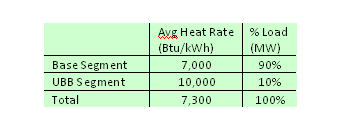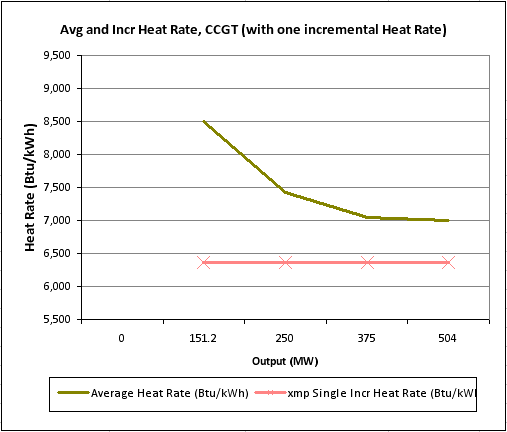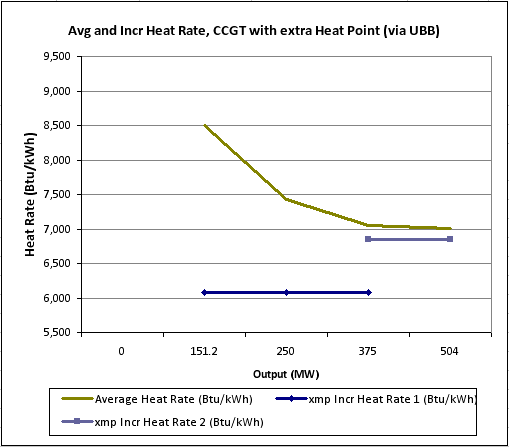Heat Rate Considerations when Using the Upper Bidding Block (UBB)
Overview
Aurora allows the user to input detailed information to represent the operation and dispatch of thermal resources. One such example is the set of Upper Bidding Block (UBB) properties, which can be used to represent additional duct firing capability on a combined cycle (CCGT), or more generally another heat/bidding point on any conventional resource. In this article, we explore the use of the UBB as it concerns heat rates.
![]() NOTE: UBB segments are not considered when the unit makes its commitment decision.
NOTE: UBB segments are not considered when the unit makes its commitment decision.
Defining the UBB Segment of a Unit
In the screenshot below, the CCGT with UBB is represented as having a capacity of 560 MW (560,000 kW), a minimum capacity of 151.2 MW (27% of the maximum capacity), a Heat Rate of 7,000 Btu/kWh and a Heat Rate at Minimum of 8,493 Btu/kWh. The UBB segment is defined as 10% of capacity. Therefore, the UBB segment is 56 MW [560 MW * 10%]. The UBB segment has a heat rate of 10,000 Btu/kWh.

![]() NOTE: The UBB segment includes the value defined in the Capacity column. In other words, the base segment, i.e., the non-UBB segment, has a capacity of 504 MW, which, when added to the 56 MW for the UBB, gives a total capacity of 560 MW.
NOTE: The UBB segment includes the value defined in the Capacity column. In other words, the base segment, i.e., the non-UBB segment, has a capacity of 504 MW, which, when added to the 56 MW for the UBB, gives a total capacity of 560 MW.
The UBB Segment and Heat Rates
Heat rates need to be given additional consideration. In Aurora, incremental (or marginal) heat rates are used to determine the dispatch cost. Average (or net) heat rates are used to report costs.
The value in the Heat Rate column is now interpreted as the base segment's full load average heat rate. The value for the UBB Heat Rate is understood to be the incremental heat rate over the segment. To obtain the average heat rate for the entire capacity of the unit, that is, over the base and the UBB together, take the weighted average of the base and UBB segments. In the above example, this value is 7,300 Btu/kWh.

In the above example, we assumed the UBB was a duct firing segment on a CCGT. The UBB could also be used to simply represent another heat point on CCGT without any duct burning capability, as illustrated in the screenshot below (“CCGT with extra Heat Point”).

The average heat rate and the marginal heat rate for the CCGT, calculated between two heat points (min and max), is illustrated in the chart below.

For the ‘CCGT with extra Heat Point’, we have added a heat point at 375 MW [504 MW *25.595%], so that Aurora will consider two marginal heat rate segments in the dispatch decision. This is shown in the chart below.

A Final Consideration
Generally, it is recommended that if a UBB is to be specified for a unit, the unit should be a commitment unit (Non Cycling > 0) and/or a must run unit (Must Run = 1). When this is not the case, the value in the Heat Rate column is used for all loading levels on the unit's base (i.e., non-UBB) segment. In the example above, if the ‘CCGT with extra Heat Point’ were not designated a commitment unit, the UBB would, therefore, end up being dispatched before the base segment (since 6,850 Btu/kWh < 7,000 Btu/kWh).
![]() UBB Heat Rate Considerations
UBB Heat Rate Considerations
